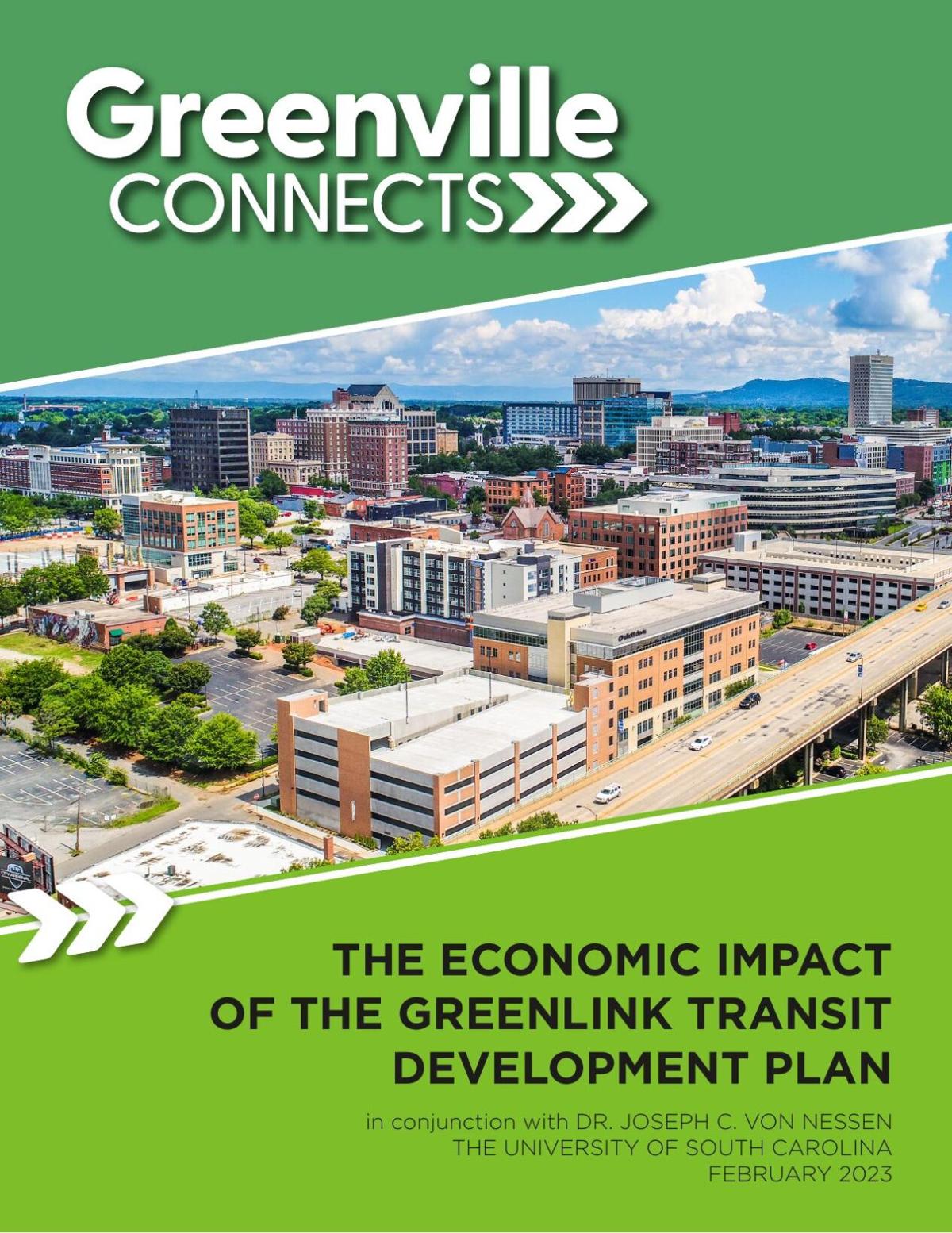GREENVILLE — An expanded Greenlink public transportation network could add anywhere from $670 million to $2 billion in new annual economic activity in Greenville County, according to a new study by a local public transportation advocacy group.
Greenville Connects commissioned Joey Von Nessen, an economics professor at the University of South Carolina, to perform an economic impact study of the potential benefit if the county and city of Greenville funded a full implementation of Greenlink’s 10-year transit development plan. The plan calls for more than doubling the number of bus routes and frequency of routes throughout the county.
Greenville Connects is a coalition of Greenville County businesses, residents and nonprofits working to increase investments in local public transportation.
Greenlink wants to add 15 new bus routes to encompass the entire county by 2030 and double the frequency of routes from 60 minutes to 30 minutes, two changes that would make the bus system more usable for residents commuting to jobs, said James Keel, Greenlink’s executive director.
More convenient bus routes to more locations in the county could allow residents who aren’t currently looking for work to fill jobs across the county. The study analyzed the number of unemployed people living within census tracts the expanded system would serve.
There are approximately 8,463 people between the ages of 25 and 54 currently unemployed or not seeking employment who live in the affected areas. If just 25 percent of those found work due to available public transportation, they would fill 2,116 jobs and generate $671 million in annual economic activity, the study found. If 75 percent found jobs, it would boost economic activity by $2 billion annually and fill 6,347 jobs, in addition to indirectly supporting 1,400 to 4,300 more jobs.
“This could be a major economic driver and we just need to really start talking about how to get this investment in the coming years so we don’t miss this opportunity,” said Erin Predmore, Greenville Connects executive director.
Greenlink has already begun to implement portions of its expansion plan. A new bus maintenance facility under construction in the New Washington Heights community, just north of the city limits, is expected to be completed by the first quarter of 2024. It will provide the backbone for the bus system to service more buses, hire more drivers, add routes and increase frequency of buses on routes, Keel said.
The next phase would be to double the frequency of stops along routes from every hour to every half-hour, he said. That would give riders better efficiency for their travel and make the system easier to navigate for work or when switching bus lines.
A full implementation would increase the number of routes the system operates from 12 to 27, bringing bus service to Fountain Inn, Mauldin, Travelers Rest, Greenville-Spartanburg International Airport, Prisma Health System and a number of busy roads and residential areas in the Greenville area. Most of those routes aren’t directly served now.
Benton Blount, a Greenville County councilman serving District 18 and the council’s liaison to Greenlink, said he saw the economic benefits an expanded system would provide the county and the Berea and Poinsett corridors in his district.
“It looks like just another testament to the potential it could bring to Greenville County because it could be a profitable thing for us, but most importantly, it would be a way for people, particularly in my district who don’t have a vehicle but are desperate for work, to have that availability,” Blount said.
This Greenlink map shows the current routes Greenlink serves in 2023.
Greenlink would need about $25 million more per year for operational costs once fully expanded, Keel said. That increased funding would come in steps over several years as Greenlink gradually hires drivers and buys buses to fill routes, Keel said.
Blount said he is researching grants and funding mechanisms to help pay for expanded service but wasn’t in favor of raising taxes to pay for public transportation when he said the county’s roads are first priority. He said he would consider public transportation as a voter referendum if roads were also addressed because that would give residents a direct vote in any tax increase.
County Councilman Alan Mitchell said the county should explore Greenlink expansion along with other options to invest in infrastructure.
“After years of growth throughout our county, our infrastructure needs more investment, and this Greenville Connects study suggests that we can get an $80-to-$1 return on transit investment,” Mitchell said.
County Council Chairman Dan Tripp said the council would discuss Greenlink expansion as part of a council retreat in anticipation of the next two-year budget. The council is scheduled to meet at 8:45 a.m. on March 14 at the Younts Conference Center at Furman University for a planning retreat about council priorities.
“Generally speaking with a growing county, with population and the road congestion that we have, there’s no question that we’ve got to have a robust functioning public transportation system and they’re part of that solution,” Tripp said.
As the county seeks to create more infill in its center to prevent further sprawl in its northern and southern areas, Greenlink would be vital to moving people around, Tripp said. He said he wasn’t sure how the county could fund $25 million more annually but that there was goodwill on the council to work with Greenlink and Greenville Connects to figure out a path forward.
Sign up for our Greenville daily update newsletter.
Sign up for daily roundups of our top stories, news and culture from the Upstate. This newsletter is hand-curated by a member of our Greenville news staff.
This content was originally published here.










